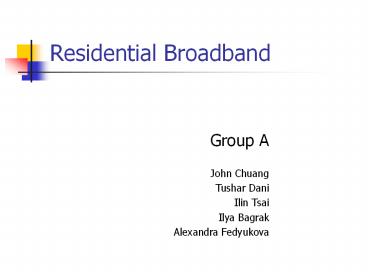Residential Broadband - PowerPoint PPT Presentation
Title:
Residential Broadband
Description:
Comcast. Time Warner Brothers. Cox. Charter. Cablevision. New ... Cox, Comcast. Telecom companies converging from telephony to video - SBC, Bellsouth, AOL ... – PowerPoint PPT presentation
Number of Views:114
Avg rating:3.0/5.0
Title: Residential Broadband
1
Residential Broadband
- Group A
- John Chuang
- Tushar Dani
- Ilin Tsai
- Ilya Bagrak
- Alexandra Fedyukova
2
Residential Broadband
- Introduction
- Market and competition
- Technology
- Economics
- Policy and regulation
- Conclusion
3
What is Residential Broadband
- Technologies that provide a high-bandwidth
connection to the Internet for residential
consumers - Replacement for the now fading residential
dial-up technology - Entirely new online experience
- Watching a video stream,
- Downloading music in seconds,
- Video and voice chats
- Real-time gaming
- This presentation is limited to US residential
Broadband market
4
Growth and Penetration
- Fast growth, 11 increase per year
- Reached more than 50 penetration already across
internet households - Several competing broadband service providers
- Telephone companies, wireless carriers, cable TV
service providers and satellite providers
5
Players
- DSL
- SBC
- Verizon
- Bellsouth
- Quest
- Cable
- Comcast
- Time Warner Brothers
- Cox
- Charter
- Cablevision
- New technologies
- Wi-Fi (Google cloud in San Francisco, hot spots)
- Satellite Signals
- Wi-Max
- BPL (broadband over power lines)
6
Market segments Prices 1
- Competition for Broadband subscribers is
bifurcating - Low end emphasizing price
- High end emphasizing speed
- DSL companies primarily target low price segment
- Started penetrating into high end market,
Verizons FiOS (15 mbps) - Cable companies have elected to stay exclusively
at the high end - Bundling as a way to reduce churn rate attract
new customers - Triple and even quadruple play
7
Market segments Prices 2
8
DSL Technology
- Limited distance to central office (CO)
- Dedicated line from CO to home
- Asymmetric flow
- Typical speeds up to 1.5Mbits/s downstream
9
Cable Technology
- Shared lines to the nearest splitter
- Generally higher speeds
- Reaches more households since distance limitation
is removed - Typical offering 4Mbits/s
- Last Mile advantage
10
Future Technology
- WiMax
- Metropolitan Area Networks (MANs)
- 3-5 miles range, no direct line of sight required
- 2Mbits/s practical limit
- Can use existing cell towers
- Broadband over Power Lines (BPL)
- More pervasive infrastructure, but requires extra
equipment - Up to 2.7Mbits/s
- Superimposing analog signal over AC
- Small deployments in operation (e.g. Manassas,
Virginia 10MBits/s for 30.00 a month)
11
Porter's Five Forces Model
- Broadband over power lines
- Wi-Fi free internet (Google)
- Municipal utility internet
- Wi-Max
New entrants
- Cable and DSL Co.
- cut-throat competition
- Trend to provide a bundle of services
- Cable companies converging from video to
telephony - - Cox, Comcast
- Telecom companies converging from telephony to
video - - SBC, Bellsouth, AOL
- Large number of
- equipment suppliers are available
- e.g. Nortel, Lucent, Cisco, Nokia etc.
- Limited companies actually own network lines,
and heavily depend on network owners
- Broadband as a Commodity.
- Some people have 3 to 4 providers to buy from
- Tend to buy bundled services
- Switching costs are low, unless annual contracts
Suppliers
Buyers
Substitutes
- TV, Music
- Newspapers
- Telephone etc
Source Michael E. Porter Competitive Strategy
Techniques for Analyzing Industries and
Competitors, (The Free Press, 1980)
12
Policy and Regulation Existing situation
- US is 16th in the world in broadband penetration
(ITU 2005 report) - Why is US so far behind?
- monopolistic structure, entrenched management,
and political power of incumbents - failure of effective policy and regulation for
broadband industry (e.g. ,FCC regulation on
spectrum allocation policy) - Legislative tug-of-war
- Preserving Innovation in Telecom Act of 2005
- Community Broadband Act of 2005
13
Policy and Regulation
- Need for national broadband strategy
- Continue to encourage highly successful open
access model in Japan - competitors may use existing residential
telephone infrastructure for a modest fee - competition and innovation ? cheap, high-speed
broadband access - Regulations for emerging technologies
- FCC better allocation of wireless spectrum
- Municipal WiFi usage
- Mixture of legislative, regulatory, and
investment initiatives
14
Conclusion
- Market Players
- Broadband will replace dial-up
- The Battle is still pretty much between Cable and
DSL companies - Technology
- New technologies such as BPL, Wi-Max, Satellite
are emerging, but are not great threat to
existing Cable DSL - Economics
- Bundling as a way to keep existing and attract
new customers - Segments based on Price and Speed
- Regulation
- Need for national broadband strategy, open
access, economic incentives
15
Conclusion
- Cable companies have advantage due to their
infrastructure and quadruple play - They will be top player in coming years
- No winner take all conditions, Cable companies,
DSL companies, and new technologies will
co-exists
16
Thank you
Clap Questions































